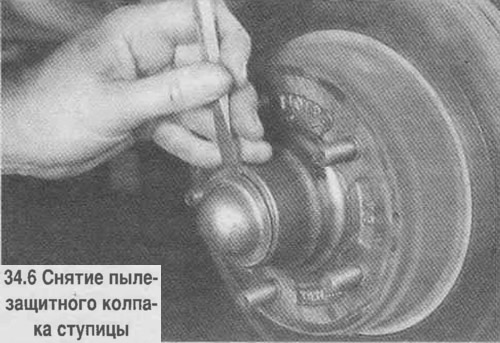For rear wheel drive models only.
1. Maintenance of front wheel bearings is generally not required. However, the condition of the bearings should be checked each time the front of the vehicle is lifted.
2. If any appreciable play is found when the wheel is rocked in a vertical plane, it is necessary to disassemble the hub assembly, change the grease in the bearings, or replace the bearings.
3. Prepare a wooden block measuring 25x12x50 mm to insert it on the brake disc between the pads.
4. Remove the wheel.
5. Remove the brake caliper, set aside and secure (Chapter 9).
6. Pry and remove the hub dust cap (see photo).

7. Unpin the nut (see photo).

8. Unscrew the nut and remove the washer from the trunnion (see photo).

9. Pull the hub/disk assembly towards you, then slide it back. In this case, the outer bearing will come out of the hub and can be removed.
10. Remove the hub/disk assembly from the trunnion.
11. Remove the oil seal from the inside of the hub (see photo). Pay attention to the initial installation of the gland.

12. Get from a nave the internal wheel bearing.
13. Remove old grease by flushing bearings and hub with solvent. Dry the parts.
14. Check the condition of the bearings for cracks, spalling, worn rollers, and other defects. Check the condition of the outer races of the bearings in the hub. If defects are found on the bearing races, the races should be replaced at a car service. After replacing the cages, the bearings also change (it is not allowed to install old bearings in new cages).
15. Fill bearings with refractory grease. Grease should enter the gaps between the rollers and the inner race (see photo).

16. Grease with a thin layer of a place of landing of bearings and a prileganiye of a working edge of an epiploon on a pin.
17. Lubricate the thrust surfaces of the bearing outer races.
18. Install the inner bearing in the hub.
19. Install a new oil seal in the back of the hub and press lightly with a hammer through a block of wood so that the surface of the oil seal is flush with the hub.
20. Carefully set the knot to step; in place, insert the outer bearing.
21. Install washer and nut. Tighten the nut with a torque of 15 Nm.
22. Rotate the hub to remove excess grease. When rotating, the rollers in the bearings will take their places.
23. Check that the torque of the nut has not changed (15 Nm.).
24. Loosen the hub nut.
25. By hand (not a key!) tighten the nut with a jerk until it stops. Cotter the nut with a new cotter pin through the hole in the threaded end of the stud. If the hole and slot in the nut do not line up, slightly loosen the nut until they line up. To install the cotter pin, the nut can be unscrewed no more than 1/2 turn from its original position (after hand tightening).
26. Bend the ends of the cotter pin so that they are flush with the nut. Trim the ends of the cotter pin if necessary.
27. Next, the assembly is performed in the reverse order. Upon completion, check the play of the wheel by shaking it in a vertical plane.
